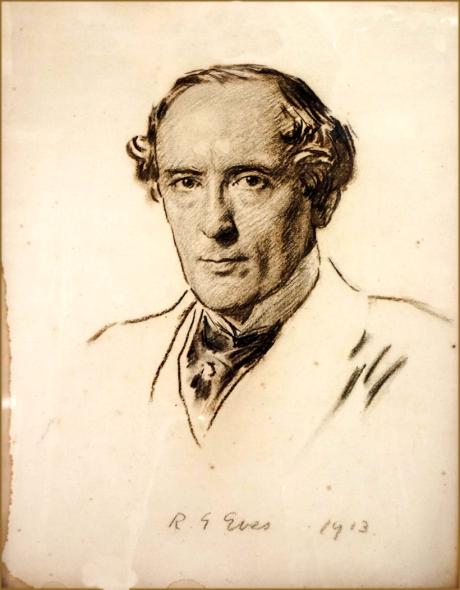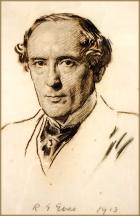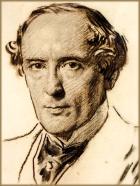and dated 1913 lower right
By direct family descent of the sitter
Harry Brodribb Irving (5 August 1870 – 17 October 1919), was a British stage actor and actor-manager; the eldest son of Sir Henry Irving and his wife Florence (née O'Callaghan), and father of designer Laurence Irving and actress Elizabeth Irving.
Although, as a child, he appeared a couple of times in his father's productions, it was intended that he would become a lawyer. He attended Marlborough College and New College, Oxford where he studied law and appeared in some student productions. Afterwards, in 1894, he was called to the Bar at the Inner Temple, but instead of pursuing a career as a barrister he decided to become an actor, taking the stage name H. B. Irving to distinguish himself from his father.
His first appearance on the stage, at age of twenty-one, was at the Garrick Theatre, London, in School. In 1906 he toured with success throughout the United States, appearing in plays made memorable by his father, The Lyons Mail, Charles I, and The Bells. In 1905 he gave a lecture, largely autobiographical, to the Academy of Dramatic Art in London. Inevitably, his early years as an actor were spent in the shadow of his father, especially as, at first, he was a member of Sir Henry Irving's Company.
In 1896, he married Dorothea Baird, who, after playing the part of Trilby the year before, was, at that time, the best known actress in Britain. HB and Dorothea had a son Laurence, who became a well known Hollywood art director, and a daughter Elizabeth. HB continued to be part of his father's company, but soon felt the need to branch out. In 1898, he joined George Alexander at the St James's Theatre where he played Don John in Much Ado About Nothing, and appeared in the surprising hit, The Ambassador, a play written by Pearl Mary Teresa Craigie.
For the following seven years, the couple, selecting the parts that appealed to them, moved between companies, sometimes together and sometimes separately. In 1900, they both appeared in Beerbohm Tree's production of A Midsummer Night's Dream that ran for 153 performances at Her Majesty's Theatre.
In 1904, only a year before his father's sudden death on 13 October 1905, Irving played Hamlet for the first time. The production, which was a popular success, was presented at the Adelphi Theatre, with Oscar Asche as Claudius, Walter Hampden as Laertes and Lily Brayton as Ophelia.
After his father's death, he established his own company, that included his wife, and toured most provincial cities, playing mainly repeats of Sir Henry Irving's best remembered performances. For the opening night of the new King's Theatre in Southsea he presented Charles I, The Bells and The Lyons Mail. Occasionally, other plays were presented including, most successfully, Dr Jekyll and Mr Hyde at the Queen's Theatre, London.
In 1911, Irving, Baird and their London Company toured Australia, again presenting Hamlet. Two years later, Baird retired from the stage, while Irving kept on performing. In 1913 he visited South Africa, and a photograph records his dinner with the Owl Club in Cape Town. In 1914, he appeared with Basil Rathbone in The Sin of David at the Savoy Theatre.
During World War I, Irving withdrew from the theatre and returned to the law, writing the study for which he is now most famous, A Book of Remarkable Criminals, originally published in 1918, which examined the lives, motivations and crimes of some infamous murderers, Life of Judge Jeffreys, French Criminals of the 19th Century and other papers on the subject. After spending twenty years of his life dedicated to the theatre, his greatest success came from being what it was intended he should be, a legal expert.
H.B.Irving was also a founding member of Our Society with Arthur Conan Doyle, Arthur Diosy, J.B. Atlay, and the Coroner Ingleby Oddie (among others). Our Society is the still flourishing "Murder" Club in London, where old crimes are discussed at regularly held dinners.
Eves, Reginald Grenville (1876–1941), painter, was born on 24 May 1876 in London, the son of William Henry Eves JP and his second wife, Anne Grenville. As a child he showed a talent for painting and drawing, and while at University College School, London, he won the Trevelyan Goodall scholarship in art, which took him to the Slade School of Fine Art. He worked there under Alphonse Legros, Frederick Brown, and Henry Tonks and won a Slade studentship.
Eves left the Slade School in 1895 and spent the next five years living on a farm near Holwick, Yorkshire, where he devoted his time to painting landscapes, animals, and portraits. In 1901 he returned to London and took a studio in Fitzroy Street; in the same year he exhibited for the first time at the Royal Academy. In 1903 he married Bertha Sybil, an artist and the younger daughter of Philip Oxenden Papillon JP and deputy lieutenant, of Crowhurst Park, Battle, Sussex, and Lexden Manor, Colchester; they had one son, Grenville Eves.
Success did not come quickly to Eves, and it was not until 1912, when his portrait of Sir Herbert Cozens-Hardy drew considerable praise, that he became a regular exhibitor at the academy. From then until his death in 1941 he exhibited every year (with the exception of 1931) never fewer than two paintings. He also exhibited at the Royal Institute of Oil Painters, the Paris Salon (where he won a gold medal in 1926), and elsewhere. His sitters were for the most part men, but his portraits of the queen of Spain (1921) and Miss Kyra Nijinsky (1935) showed that he could be equally successful in painting women. During his career he painted many of the most prominent figures in British public and artistic life. His portraits of George VI (1924), Sir Ernest Shackleton (1921), Thomas Hardy (1923), Sir Frank Benson (1924), Stanley Baldwin (1933), Lord Jellicoe (1935), Geoffrey Fisher, archbishop of Canterbury, Leslie Howard, Sir Frederick Pollock (c.1926), Sir William Watson (1929?), and Sir Charles Scott Sherrington (1927) are in the National Portrait Gallery; another portrait of Hardy (1924) and one of Max Beerbohm (1936) are in the Tate collection, the latter having been purchased by the Chantrey bequest in 1937. Although the majority of these are now perceived as unimaginative, the status of his sitters indicates that Eves achieved a highly successful portrait practice.
In 1931 there was a controversy concerning some architectural paintings which Eves had sent to the Royal Academy and which were rejected on the ground that a photographic process had been used at one stage in their production. Eves claimed ignorance of the regulation forbidding such a practice. This slight conflict did not, however, hold up his advancement, for in 1933 he became an ARA and in 1939 an RA. In 1940 he was appointed an official war artist, and in 1941, at the time of his death, eight portraits by him of war leaders were on exhibition at the National Gallery.
Eves had a remarkable gift for catching and fixing a characteristic expression. He developed a trademark style in which loosely worked backgrounds and unfinished edges give the impression of a spontaneous sketch. Although he worked mainly in portraiture, he also painted landscapes in oil and watercolour in a style which owed something to Whistler and Philip Wilson Steer. Eves died at 25 Bridge Street, Middleton in Teesdale, co. Durham, on 14 June 1941. A retrospective exhibition of his work was held at the gallery of the Royal Society of British Artists in 1947.
James Laver, rev. Ben Whitworth DNB



